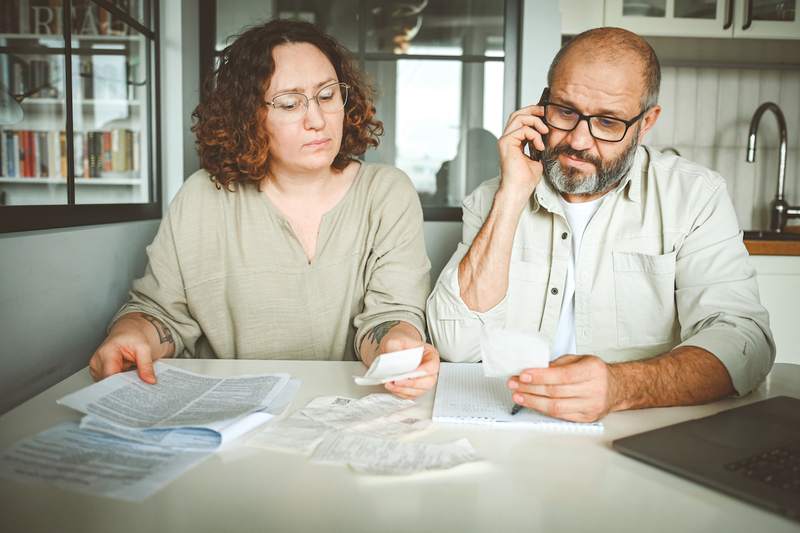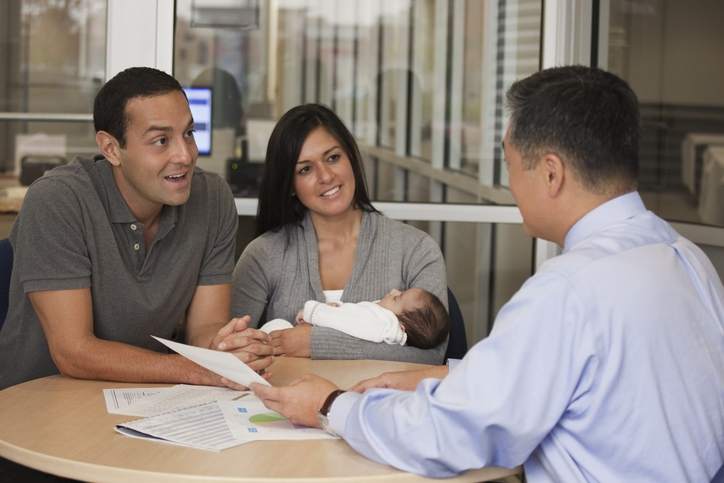More than three-quarters of people 50 and older want to continue living in their homes as long as possible. That’s not always easy. Many retirees live on a fixed income, which can make it difficult to afford the rising cost of living — let alone handle major expenses such as medical care.
While many older homeowners are strapped for cash, they often are “house rich” at the same time. Nearly 80% of adults 65 and older own their homes, and such homeowners have on average $143,000 in home equity.
Borrowing home equity as cash — either with a reverse mortgage or a cash-out refinance — is one way older homeowners can solve this dilemma. But these loan types work in very different ways, so it’s important to understand and weigh the advantages and disadvantages of each before deciding which might be best for you.
- A reverse mortgage allows homeowners 62 and older to convert their home equity into income, letting them stay in their home and repay the loan when they no longer live in it.
- A cash-out refinance involves replacing your current loan with a larger loan, giving you a lump sum of cash to use as you wish. You repay it as part of your new mortgage.
- A reverse mortgage may be a better choice if you don’t plan to pass on your equity to family or heirs. A cash-out refinance may be better if you can afford a mortgage payment and want to rebuild your equity.
What Is a Reverse Mortgage?
A reverse mortgage is a loan that lets older homeowners borrow their home’s equity while continuing to live in it. Instead of paying the lender and reducing the mortgage principal owed, the lender pays you and increases the principal owed.
The most common type of reverse mortgage is a home equity conversion mortgage, which is insured by the Federal Housing Administration and available through private lenders to homeowners 62 and older.
The money that’s paid out in a reverse mortgage usually is tax-free, and does not affect your eligibility for Medicare or Social Security benefits. The borrowed money can be disbursed as a lump sum, a monthly payment, a line of credit, or a combination of those options.
Over time, the principal on a reverse mortgage will increase and accrue interest. The loan must be repaid when you no longer live in the home — usually because you’ve moved out, sold the home, or died. Typically, the owner or their heirs sell the home and use the proceeds to repay the principal on the reverse mortgage.
How much can you get with a reverse mortgage?
The amount you borrow with a reverse mortgage depends on the value of your home and any outstanding debts you have against it. The more equity that you have, the more you can borrow.
Other factors that play a role include your age and how you wish to receive the funds. Older borrowers usually get larger payments.
When taking out an FHA-backed home equity conversion mortgage, the maximum you can borrow is the lesser of:
- The home’s appraised value.
- The sale price, if you’re using a home equity conversion mortgage to buy a home.
- The federal conforming conventional loan limit for high-cost areas, which is $1,149,825 in 2024.
What Is a Cash-Out Refinance?
A cash-out refinance involves taking out a new mortgage for more than you owe on your current home loan. You pay off the original loan and keep the difference — repaying the cash you borrowed as part of your new mortgage.
For example, if you owe $120,000 on your mortgage and your home is worth $250,000, you could refinance with a new mortgage for $200,000. After paying off the original loan, you would have $80,000 in cash to use as you like, and retain $50,000 in equity. The cash you borrow is repaid as part of the new mortgage.
How much equity you can borrow with a cash-out refinance depends on the lender’s terms, your home’s loan-to-value ratio, and your credit score.
Cash-out refinancing also lets you change the terms of your mortgage, which may allow you to get a lower interest rate on your new loan. Additionally, it lets you change your mortgage type and loan term, which can reduce the monthly payment or let you pay it off more quickly.
How much can you get with a cash-out refinance?
You typically can borrow up to 80% of your home’s value with a cash-out refinance, though that amount varies depending on which type of mortgage you choose. How much you can keep depends on how much you owe on your current mortgage. Remember, you also have to pay refinance closing costs, which average about $5,000.
Reverse Mortgage vs. Cash-Out Refinance: The Differences
When it comes to a cash-out refinance vs. reverse mortgage, it’s important to understand the differences. Your age, your finances, how much you’re looking to borrow, and market conditions all play a role in deciding which option is best for you.
Disbursement and repayment
With a cash-out refinance, you receive your money as a lump sum shortly after closing. Repaying a cash-out refinance is like repaying your previous mortgage. You make monthly payments to the lender until the loan is paid off, you refinance again, or you sell the home.
In the case of reverse mortgages, after you decide how you want to receive your loan, there are no monthly payments to make. While that may sound great, keep in mind that your debt is growing. The balance will increase with each payment you receive — and you’ll be charged interest on that balance until the loan is repaid.
Eligibility requirements
To get a reverse mortgage, you must in almost all cases be 62 or older, and the reverse mortgage must be for your primary residence. You also will need at least about 50% equity in your home, which must be in good shape. You must be able to continue paying for homeowners insurance and property taxes.
As for a cash-out refinance, you essentially must meet the same criteria for getting a mortgage as if you’re buying a home. You usually must have at least 20% equity in your home. You typically need a credit score of at least 620, and lenders will calculate your debt-to-income ratio — lower is better. You must have been on the property’s title for at least six months, and a refinance appraisal and a new home inspection may be required.
Impact on equity
When you take out a reverse mortgage, the money is paid directly to you as long as you live in the home. Your balance will increase every time you receive cash, and your equity in the home will decrease. When it comes time to sell, you’ll keep less of the proceeds — possibly none if you’ve used all your equity.
With a cash-out refinance, your equity will receive a hit when you take out the funds. But as you make payments, your balance will decrease, and your equity will increase. Unless your home declines in value, you should have more equity to keep when you sell the home — up to 100% if you pay off your new mortgage completely.
When Is a Reverse Mortgage Better?
Reverse mortgages can be useful in a variety of situations.
You plan to stay in your home
One of the biggest advantages of a reverse mortgage is that you can keep living in your home while accessing its equity. Rather than having to sell the property or get a loan that requires payments, you can stay in your home and receive payments.
You are retired and can’t qualify for a new mortgage
If you’re retired, you might not have sufficient income to qualify for a new mortgage. That rules out options like home equity loans or home equity lines of credit because most types of lenders require you to have enough income to afford the loan.
You aren’t leaving your home to heirs
When you get a reverse mortgage, you must repay the loan when you stop occupying the home as your primary residence. Often, repayment is made by selling the home or handing over the deed to the lender. That makes these loans a poor option for those who want to leave their home to heirs.
On the other hand, as long as you plan to stay in your current home, your taxes are all up to date, and you don’t plan on passing on your home, a reverse mortgage could be right for you, says Linda McCoy, a mortgage broker based in Mobile, Alabama.
“The perfect couple for a reverse mortgage is retiring, in their late 70s, have a lot of equity in their home, and they now want to enjoy the years they have left,” McCoy says. “With a reverse, they can take a large chunk of money out to put into their bank, pay off all their bills, and get some golf clubs and go play and travel knowing there is money in the bank to pay their normal bills with no mortgage payment.”
You need a steady cash flow
One of the most popular ways to get money from a reverse mortgage is a monthly payment. Your reverse mortgage will turn your equity into a series of fixed payments that you can rely on every month to help pay your bills.
When Is a Cash-Out Refinance Better?
Cash-out refinancing may be a better fit in many situations.
You’re not 62 years old yet
To qualify for a home equity conversion mortgage, you need to be at least 62 years old. If you’re younger than that, you’re ineligible. A cash-out refinance has no minimum age requirement.
You have income and can afford a mortgage payment
If you are still working or have sufficient income to afford payments on a new mortgage, a cash-out refinance may be a better fit because paying down your balance will grow your equity. This is especially true if you want to use the funds for a specific purpose rather than ongoing living expenses.
“The perfect cash-out client would be one that had a lot of equity in their home and wanted to remodel, take cash out to consolidate all they owed, and add on that room at the same time, with no private mortgage insurance and get a lower interest rate than their previous mortgage,” McCoy says.
You plan to leave the home to heirs
Reverse mortgages deplete your equity, reducing how much your heirs could get from a sale of the home. With a cash-out refinance, you can rebuild your equity and have more to pass along.
You want to change your loan terms
A reverse mortgage is designed very specifically to help older people afford to stay in their homes. If what you’re looking to do is adjust the details of your mortgage — the loan term, loan type, or interest rate — a cash-out refinance is the better way to go.
You want to rebuild your home equity
A cash-out refinance decreases your equity with a one-time hit, but you can rebuild your equity over time as you make payments. Reverse mortgages will deplete your equity as you use the funds.
FAQ: Reverse Mortgage vs. Cash-Out Refinance
Here are answers to common questions about a reverse mortgage vs. cash-out refinance.
With some types of reverse mortgages, you’ll stop receiving payments if you outlive the funds. Other types, such as a tenure reverse mortgage, will disburse payments for life — even if it puts you underwater on your home.
No. You or your heirs can repay the loan or refinance to a regular mortgage and keep the home.
The 60% rule for reverse mortgages states that the most that you can borrow in the first year of a reverse mortgage is 60% of the principal limit. That means that if you’re approved to borrow up to $100,000 using a reverse mortgage, you can only receive up to $60,000 in the first year.
The Bottom Line on Reverse Mortgages vs. Cash-Out Refinances
Your home is one of the biggest investments you’ll ever make. Over time, your equity will become an asset that grows while you get older. By being able to leverage that equity through a reverse mortgage or a cash-out refinance, you can take care of other financial needs in your later years. Understanding how these loan types differ will help you choose the option that best fits you.
More From LowerMyBills:
- What Is a Reverse Mortgage, and How Does It Work?
- Is My Home Eligible for a Reverse Mortgage?
- Reverse Mortgage Documents: What Do You Need?
- What Is a LESA for a Reverse Mortgage?
- Reverse Mortgage Insurance: What You Need To Know
- Making Reverse Mortgage Payments: How It Works
- Reverse Mortgage Payment Options
- How To Pay Off a Reverse Mortgage Early
T.J. Porter contributed to the reporting of this article.
- AARP (2022)
- U.S. Census Bureau (2023)
- Joint Center for Housing Studies of Harvard University (2018)






